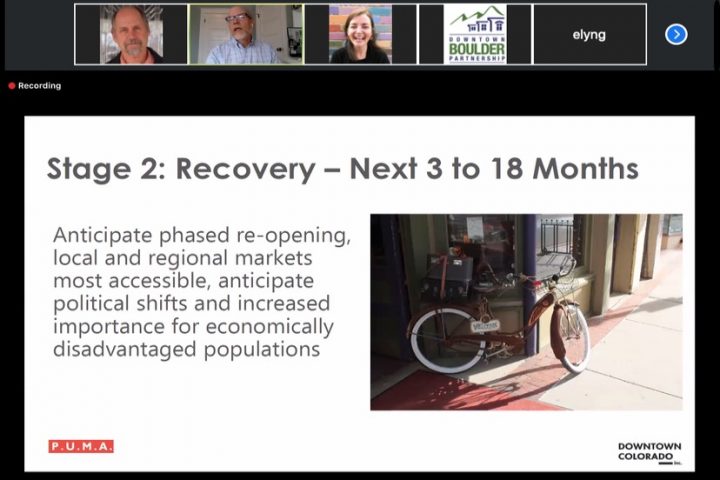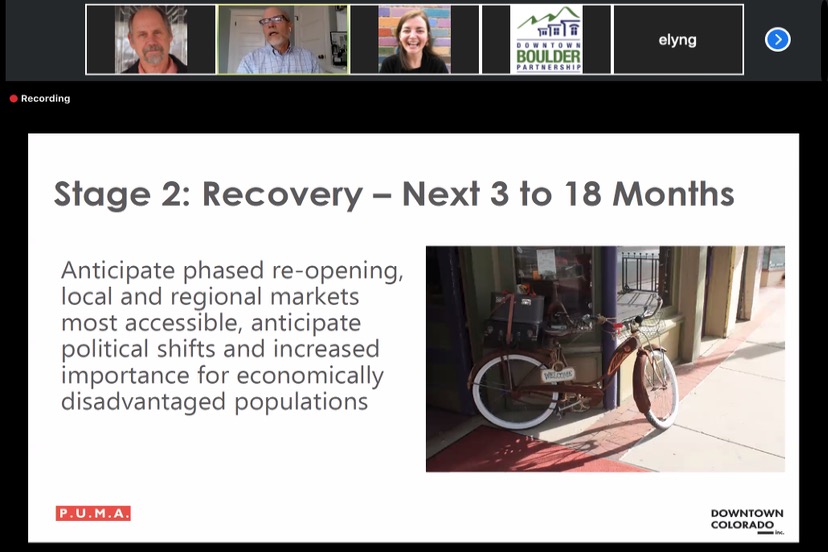So many things are uncertain, as the summer tourist season approaches. Colorado health officials expect the number of reported COVID-19 fatalities to jump dramatically this week — not necessarily because more people have died of the infection, but partly because they’ve decided to include “probable” COVID deaths in the count.
“This is not because those individuals died this week, but because their deaths have now been recorded in the state system,” health officials noted in a news release about the expected surge in deaths.
Downtown Colorado, Inc. — a non-profit membership association “committed to building better communities by providing assistance to Colorado downtowns, commercial districts and town centers” — hosted a Zoom meeting yesterday, to help its members address questions like “What the hell do we do now?” DCI members include downtown organizations, local governments, development and improvement districts, consultants, individuals and others involved in downtown and community development. The Town of Pagosa Springs is one of those 500 members.
Yesterday’s Zoom presentation involved a Denver-based planning firm named Progressive Urban Management Associates (P.U.M.A.) that describes itself as “a leader in guiding downtowns, neighborhoods, and communities to prepare for the future.”
As most of our readers know, Pagosa Springs has an existing historical downtown — the kind of downtown capable of serving a population of 2,000 people back in the days of lumber mills and cattle ranches. But since the arrival, in the 1970s, of the Fairfield Pagosa development four miles to the west (now better known as Pagosa Lakes) much of the community’s retail activity takes place “uptown” where there are plenty of large asphalt parking lots to accommodate our suburban automobile-centric lifestyle.
The PUMA experts who shared their ideas during yesterday’s Zoom meeting have obviously given considerable thought to the problems facing the average Colorado ‘downtown’, as the COVID-19 pandemic and the resulting public health orders make their mark on society.
As the experts were all too willing to admit, no one really knows where this whole thing is headed. Or how long it will last.
PUMA President Brad Segal noted that, in his 40 years in the urban planning business, he’s not seen anything like the current situation. What PUMA hoped to share was a useful “framework” that would allow downtown organizers set priorities, if and when an economic recovery takes place.
For example. Will your community be prioritizing — possibly for the first time — the economically disadvantaged segments of the community?

We don’t all share the same priorities during this economic slowdown.Some of us feel ‘safety’ is the number one priority. Some feel ‘money’ is more important than ‘safety.’ Some just want a chance to sit around a table with friends.
Mr. Segal:
“Like most of you, at PUMA we were pretty shocked in March. We were reacting daily to the different changes, but unlike you, we had the luxury of being a step removed from the front lines…
“The framework — we hope it’s helpful, we hope its useful in framing your own organizational response. But it’s the type of thing you really need to adapt to your own unique situations… If you find this useful, you will want to develop your own measurements, your own metrics…
“And as I mentioned before, this is going to be dynamic. We need to be ready to change it up, week to week. There may be actions that we’re suggesting today that, two weeks from now, just don’t make any sense. So what new actions are we introducing?
“And I think maybe one of the most important things in this whole exercise — allowing you all to let go of things, you know. Are there some things that we just can’t do, because we’ve got to allocate resources somewhere else?
“I know many of you who are ‘resort based’ are just getting hammered by this. You know, the initial stage is really tough, because we’re really reliant on our local market to sustain what we have in our [downtown] district, because we just don’t have the tourists. We don’t even have a regional market.
“I think as the restrictions are released, you might see a lot of activity coming from the Front Range. Which is a double-edged sword. On the one hand, you need the business, and on the other hand, you don’t need the virus…”
I’d like to comment on Mr. Segal’s comment, because the “first phase” of any recovery in Pagosa Springs — the phase where local residents are allowed to come hesitantly out of their homes, and begin doing “non-essential” activities, and where the tourists have not yet returned — that first phase is going to be especially hard on downtown Pagosa Springs. Over the past 30 years, not only have the larger retailers moved out of downtown and relocated uptown, but the nature of downtown shopping has trended strongly towards tourist oriented ‘gift shops’ drawing their customers from three nearby hot springs bathing establishments.
Even if the ‘stay at home’ restrictions are eased, I’m not sure how many locals, or tourists, are going to be eager to sit in a bathing pool, or swim in a swimming pool, in rather close proximity to people they’re never met?
If the hot springs were to lose their popularity for several months — or years — I can’t imagine how the current gift shops in downtown could endure. And all it takes is 30% of a downtown to be boarded up and vacant, to kill most of the rest of the businesses.
When a community builds an economic house of cards based on tourism, in its downtown core… and then the public health industry convinces people to be afraid of gatherings… well, it’s not going to be a pretty picture.

